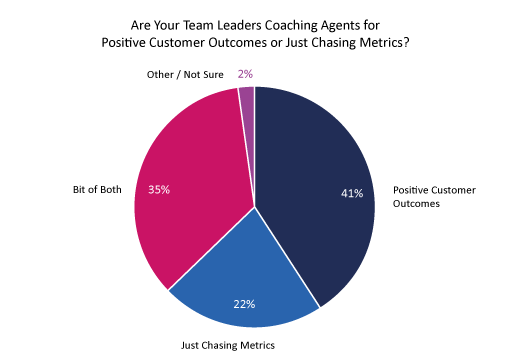Obsessing over metrics can distract team leaders from driving good behaviours in agents.
Garry Gormley, Founder, CEO – FAB Outsourced Solutions, explains how to spot if your team leaders are chasing metrics, and how to hit the reset button if you need to.
Team Leaders Move From the Frontline Into Leadership Roles Practically Overnight
The contact centre team leader role is possibly one of the most challenging roles in the contact centre.
Thanks to a lot of team leaders being promoted internally, we often see them moving from the frontline one day and becoming a leader of people the next day, having been officially knighted into the world of leadership.
But do the frontline team leaders get the right level of support and investment to be able to do the job to the best possible standard?
And how do we ensure team leaders understand how to monitor performance and coach behaviours over metrics?
To better prepare agents for team leadership positions, read our article: How to Prepare Agents for Team Leader Roles
Less Than Half of Team Leaders Are Coaching Agents for Positive Customer Outcomes
The current picture is alarming. A recent Call Centre Helper LinkedIn poll asked ‘Are Your Team Leaders Coaching Agents for Positive Customer Outcomes or Just Chasing Metrics?’.

| Coaching Purpose | Response % |
|---|---|
| Positive Customer Outcomes | 41% |
| Just Chasing Metrics | 22% |
| Bit of Both | 35% |
| Other / Not Sure | 2% |
The results from 470 participants highlighted that there’s definitely some work to do in this area – as less than half (41%) are thought to coach for ‘Positive Customer Outcomes’, with a further 35% saying they do a ‘Bit of Both’, while 22% of team leaders are thought to be ‘Just Chasing Metrics’ alone.
So What Are the Signs Team Leaders Are Chasing Metrics Rather Than Coaching Good Behaviours?
Here are three ways to spot if your team leaders are too busy chasing metrics:
1. The Quality of the Conversations You Observe
This sounds obvious, but how often do we find time to observe team leaders in a 1-2-1 discussing the “how” and the “why” over the numbers themselves?
2. Too Much Time in Front of Wallboards
One of the key signs your team leaders are chasing metrics is that your team are spending too much time poring over the wallboards’ real-time screens and reports over listening to calls to capture and correct behaviours that drive the number.
Looking for wallboard inspiration, read our article: What Should You Be Displaying on Your Contact Centre Wallboards?
3. All the Talk Is About Numbers and Not Customer Outcomes
The numbers can be important, but the customer outcome is equally important.
So, this should be balanced with conversations about quality, feedback, questioning skills, listening skills, call control, and tone and pace.
Focusing too much on the metric itself, and not the behaviours or the skills that drive it, can lead to underperformance.
What Gets Measured Gets Managed
Two quotes I always refer to with leadership teams are “What gets measured gets managed” and “Measure what matters”.
These only really came to me in my later years of management, and I wish I’d come across them in my more formative leadership years.
As team leaders, we are often chasing the numbers and, let’s face it, there are so many numbers to chase in the contact centre that it can be a struggle not to!
AHT, Shrinkage, Service levels, Productivity… The list goes on, but ultimately the numbers don’t change if we don’t tackle the behaviours that positively influence the result!
So, let’s talk about how we drive the behaviours that help deliver results…
Are Your Team Leaders Clear on the Metrics That Matter?
Before we do this, we have to look internally and ask:
- Are our team leaders really clear on the metrics that do actually matter?
- Are we clear with our frontline teams about what these are and why they are important?
- What part does the team play in delivering great customer experience and good customer outcomes?
- How do the metrics we use to monitor performance link back to this?
A top tip for your team leaders when trying to answer these questions is to start with listing the KPIs and metrics that you use to monitor frontline agents’ performance and asking the following questions…
- What is the target or the expectation?
- Why is this important?
- What’s the impact of not achieving this on the customer, the business, and the team?
- Why might an agent not be achieving this?
- What behaviours might they be displaying that are impacting performance?
Doing this exercise acts as great preparation for having a good coaching discussion and ensuring that team leaders are clear on the importance of your metrics, so they can coach the team on the outcome rather than the number.
How to Shift the Focus Towards a Coaching Culture
So what can you do to shift the focus more towards a coaching culture that acknowledges the behaviours and the efforts required to achieve KPIs?
Here are three top tips to shift the focus towards a coaching culture:
1. Share the Bigger Picture
It’s important to share the bigger picture with your team leaders.
Not only why we do what we do, but also the part the agent plays in the wider business, so they understand clearly why the metrics are important and how this impacts the customer and the rest of the business.
For advice on developing internal communication, read our article: How to Improve Internal Communication in the Contact Centre
2. Celebrate Success Against Behaviours and Improvements
…As well as the performance against the KPIs themselves!
Sharing with your team what good looks like and great examples of agents who demonstrate these behaviours can help people strive towards the same standards.
Try creating a ‘good call library’ or pairing agents up together.
3. Inspect What You Expect
Nurture your team leader population to have fuller and more probing conversations in 1-2-1s and coaching sessions by observing these sessions and giving them feedback.

If 1-2-1s are transactional and short and focused on numbers, you will see limited improvement. If you can shift the conversation to more probing and action-focused conversations, we’ll get more traction quicker.
So, to summarize, if you want to shift the needle on performance, you need to shift conversations towards behaviours that influence the performance!
Written by: Garry Gormley, Founder, CEO – FAB Outsourced Solutions
For more insightful articles on team management and metrics, read these next:
- Team Leadership: What Makes a Great Leader?
- 9 Traits of High-Performing Team Leaders
- 10 Metrics to Help You Measure the Customer Experience
- The Best Metrics for Contact Centre Performance Tracking
Author: Garry Gormley
Reviewed by: Megan Jones
Published On: 15th May 2023 - Last modified: 24th Sep 2025
Read more about - Call Centre Management, Editor's Picks, Employee Engagement, Garry Gormley, Leadership, Management Strategies, Metrics, Team Management










































